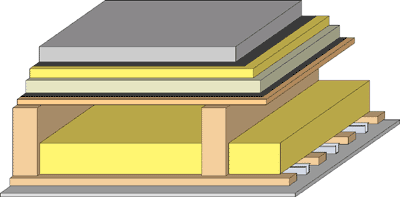Geprüftes/zugelassenes Bauteil
intermediate floor gdrnxa07a-04
intermediate floor timber frame construction, suspended, wet, with filling
Building physical assessment
| Fire performance | REI | 30 |
|---|---|---|
|
maximum span = 5 m; maximum load Ed,fi = 3,66 kN/m² (without floor construction; with ceiling beam 80/200); REI60: if 200 mm mineral wool ≥ 1000°C and insulation protection is built-in (metal strip: b = 100 mm, e ≤ 300 mm; d = 0,5-1,0 mm), maximum span = 5 m; maximum load Ed,fi = 3,0 kN/m²
Classified by IBS Classified by HFA
Fire performance Germany
Classification: F30
Load Ed,fi according to the German certification document
Proof: DIN 4102-4:2016-05, Tabelle 10.12, Zeile 1
|
||
| Thermal performance | U | 0,26 W/(m2K) |
| Diffusion | adequate | |
|
Calculated by HFA
|
||
| Acoustic performance | Rw (C;Ctr) | 70 dB (-1; -5) |
| Ln,w (Cl) | 41 dB (1) | |
|
Assessed by TGM
Rating by Müller-BBM
|
||
| Mass per unit area | m | 216,9 kg/m2 |
|
Calculation based on gypsum plaster board type DF GKF
|
||
Only for registered members after logging in.


Register of building materials used for this application, cross-section (from outside to inside)
| Thickness [mm] | Building material | Thermal performance | Reaction to fireklasse EN | ||||
|---|---|---|---|---|---|---|---|
| λ | μ min – max | ρ | c | ||||
| A | 50,0 | cement screed or anhydrite screed | 1,330 | 50-100 | 2000 | 1,080 | A1 |
| B | plastic separation layer | 0,200 | 100000 | 1400 | 1,400 | E | |
| C | 30,0 | impact sound absorbing subflooring MW-T [s'=10 MN/m³] | 0,035 | 1 | 68 | 1,030 | A1 |
| D | 40,0 | fill loose | 0,700 | 1 | 1800 | 1,000 | A1 |
| E | trickling protection | E | |||||
| F | 18,0 | OSB | 0,130 | 200 | 600 | 1,700 | D |
| G | 220,0 | construction timber (80/..; e=625) | 0,120 | 50 | 450 | 1,600 | D |
| H | 100,0 | mineral wool [038; ≥33; ≥1000°C] | 0,038 | 1 | 33 | 1,030 | A1 |
| I | 24,0 | spruce wood cladding with spacing of cladding boards(24/100); a=400 | 0,120 | 50 | 450 | 1,600 | D |
| J | 27,0 | resilient channel placed between cladding with spacing | |||||
| K | 12,5 | gypsum plaster board type DF or | 0,250 | 10 | 800 | 1,050 | A2 |
| K | 12,5 | gypsum fibre board | 0,320 | 21 | 1000 | 1,100 | A2 |
Ecological rating (per m2 construction area)
Details of sustainability rating...
| Global warming potential | Share of renewable Primary Energy | Resources | |||||||||||
|---|---|---|---|---|---|---|---|---|---|---|---|---|---|
| Lifecycle Phase |
GWP-F [kgCO2Äqv.] |
GWP-B [kgCO2Äqv.] |
GWP-T [kgCO2Äqv.] |
PERE [MJ] |
PERM [MJ] |
PERT [MJ] |
PENRE [MJ] |
PENRM [MJ] |
PENRT [MJ] |
AP [kgSO2Äqv.] |
EP [kgPO4Äqv.] |
ODP [kgR11Äqv.] |
POCP [kgEthenÄqv.] |
| A1 - A3 | 41,173 | -44,143 | -2,970 | 107,456 | 455,553 | 563,008 | 550,596 | 20,654 | 571,250 | 0,176 | 0,076 | 2.5171422E-6 | 0,043 |
Details of sustainability rating...
| Resources | |||||||||||
|---|---|---|---|---|---|---|---|---|---|---|---|
| Lifecycle Phase |
GWP [kgCO2Äqv.] |
AP [kgSO2Äqv.] |
EP [kgPO4Äqv.] |
ODP [kgR11Äqv.] |
POCP [kgEthenÄqv.] |
PERE [MJ] |
PERM [MJ] |
PERT [MJ] |
PENRE [MJ] |
PENRM [MJ] |
PENRT [MJ] |
| A1 - A3 | -5,444 | 0,146 | 0,021 | 8.86E-7 | 0,023 | 141,937 | 483,451 | 626,814 | 505,514 | 54,730 | 560,381 |
| C1 - C4 | 48,726 | 0,015 | 0,005 | 6.46E-8 | 0,002 | 2,205 | -476,814 | -473,469 | 22,441 | -7,731 | 30,310 |
| A1 - C4 | 45,662 | 0,165 | 0,027 | 9.59E-7 | 0,024 | 144,526 | 6,896 | 154,473 | 533,918 | 47,052 | 604,846 |
Last update 02.08.2023/hfa.eco2soft